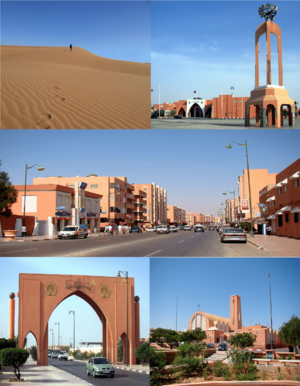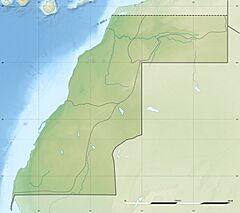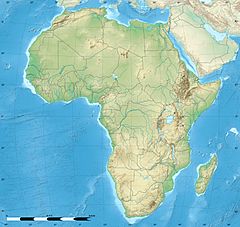Laayoune facts for kids
Quick facts for kids
Laayoune
العيون (Arabic)
El Aaiún
|
|
|---|---|
|
City
|
|

Left to right, top to bottom: Footprints on the sand, Place Mechouar, Street, Monumental Arch, Laayoune Cathedral
|
|
| Non-self-governing territory | Western Sahara |
| Claimed by | |
| Controlled by | |
| Region | Laâyoune-Sakia El Hamra |
| Province | Laâyoune |
| Settled | 1934 |
| Founded | 1938 |
| Founded by | Antonio de Oro |
| Area | |
| • Total | 247.8 km2 (95.68 sq mi) |
| Population
(2014)
|
|
| • Total | 217,732 |
| • Density | 878.66/km2 (2,275.63/sq mi) |
| Time zone | UTC+01:00 (West Africa Time) |
| • Summer (DST) | (Not Observed) |
Laayoune (pronounced lah-YOON) or El Aaiún (pronounced EL eye-YOON) is the biggest city in a place called Western Sahara. This area is currently under discussion about who should govern it. The name Laayoune means "The Springs" in Arabic, referring to water sources.
In 2023, about 271,344 people lived there. Even though Morocco manages the city, the United Nations (UN) has a special mission called MINURSO that helps keep an eye on things. The city is located near a dry river called Saguia el-Hamra. An old church, the St. Francis of Assisi Cathedral, built by the Spanish, is still active today.
Contents
About Laayoune
Laayoune is the biggest city in the Western Sahara region. It is a very important place for the people who live there and for the countries that claim the territory.
A Look Back: History of Laayoune
Early Days and Spanish Rule
The city's name, Laayoune, comes from an Arabic word meaning "the springs." This is because of the natural water sources found there. A Spanish captain named Antonio de Oro started Laayoune in 1938. It began as a small military base. Soon, it became the main center for the Spanish territory known as Spanish Sahara.
The Spanish chose this spot for two main reasons. First, there was water available. Second, it was a great military location. Being near the Saguia el-Hamra river also made it easy to connect with nearby ports.
Growth and Changes
In the 1940s, Laayoune grew quickly. This was because large amounts of phosphates were found nearby at a place called Bou Craa. Phosphates are minerals used to make fertilizers. This discovery led to a big industry in the city.
In 1970, there was a protest in Laayoune called the Zemla Intifada. Sadly, some people were hurt or died during this event. After Spain left in 1975, Morocco took control of Laayoune and much of Western Sahara. Many Moroccans moved to the city. They now make up a larger part of the population than the original Sahrawis people. The Sahrawis slowly changed from their traditional nomadic way of life.
Laayoune has continued to grow and develop. It even has a special plant that turns seawater into fresh drinking water, called a desalination plant.
Weather and Climate
Laayoune has a hot desert climate. This means it's usually very warm and dry. The average temperature is around 21 degrees Celsius (70 degrees Fahrenheit). The nearby Canary Current in the ocean helps to make the weather a little milder.
| Climate data for Laayoune (1981–2010 normals) | |||||||||||||
|---|---|---|---|---|---|---|---|---|---|---|---|---|---|
| Month | Jan | Feb | Mar | Apr | May | Jun | Jul | Aug | Sep | Oct | Nov | Dec | Year |
| Mean daily maximum °C (°F) | 22.2 (72.0) |
22.7 (72.9) |
24.5 (76.1) |
23.9 (75.0) |
25.6 (78.1) |
27.4 (81.3) |
29.5 (85.1) |
30.4 (86.7) |
30.0 (86.0) |
28.6 (83.5) |
26.0 (78.8) |
23.2 (73.8) |
26.2 (79.2) |
| Daily mean °C (°F) | 16.9 (62.4) |
17.6 (63.7) |
19.2 (66.6) |
19.2 (66.6) |
20.7 (69.3) |
22.5 (72.5) |
24.5 (76.1) |
25.2 (77.4) |
24.7 (76.5) |
23.3 (73.9) |
20.8 (69.4) |
18.0 (64.4) |
21.1 (70.0) |
| Mean daily minimum °C (°F) | 11.6 (52.9) |
12.5 (54.5) |
13.9 (57.0) |
14.5 (58.1) |
15.8 (60.4) |
17.7 (63.9) |
19.4 (66.9) |
20.0 (68.0) |
19.4 (66.9) |
18.0 (64.4) |
15.6 (60.1) |
12.8 (55.0) |
15.9 (60.6) |
| Average precipitation mm (inches) | 11.1 (0.44) |
11.1 (0.44) |
5.4 (0.21) |
1.1 (0.04) |
0.5 (0.02) |
0.0 (0.0) |
0.1 (0.00) |
0.5 (0.02) |
1.5 (0.06) |
3.0 (0.12) |
9.8 (0.39) |
13.3 (0.52) |
57.4 (2.26) |
| Mean monthly sunshine hours | 239.1 | 234.7 | 281.4 | 296.5 | 326.5 | 308.9 | 290.3 | 286.9 | 260.1 | 266.1 | 243.9 | 229.8 | 3,264.2 |
| Source: NOAA | |||||||||||||
Future Climate Changes
Scientists have studied how Laayoune's climate might change. By the year 2050, the city's weather could become even warmer. The average yearly temperature might go up by about 1 degree Celsius. The hottest month could see an increase of almost 2 degrees Celsius.
People of Laayoune
Laayoune is the largest city in Western Sahara. In 2023, its population was 271,344 people. The city has grown a lot over the years.
| Year | Population |
|---|---|
| 1982 (Census) | 93,875 |
| 1994 (Census) | 136,950 |
| 2004 (Census) | 183,691 |
| 2014 (Census) | 217,732 |
| 2023 | 271,344 |
What Laayoune Does: Economy
Laayoune is a busy place for two main activities: fishing and phosphate mining. Fishing boats bring in seafood from the ocean. The city also processes the phosphates dug up from the ground. These industries are very important for the city's economy.
Fun and Learning in Laayoune
Sports
The city has a football (soccer) team called Jeunesse Massira. They play in the Moroccan Second Division, which is the second-highest football league in the country. They train and play their games at Stade Sheikh Mohamed Laghdaf.
Getting Around
Laayoune has an international airport called Hassan I Airport. This airport helps people travel to and from the city.
Schools and Learning
For education, Laayoune has a French school that opened in 2018. There is also a Spanish international school called Colegio Español La Paz. This school is owned by the Spanish government.
International Connections
Many countries have opened special offices called consulates in Laayoune. A consulate is like a small embassy that helps citizens from that country and promotes business. Starting in 2019, countries like Comoros, Gabon, São Tomé and Príncipe, the Central African Republic, Ivory Coast, Burundi, Eswatini, Zambia, the United Arab Emirates, and Bahrain have opened consulates here. This shows their support for Morocco's claims to the region.
Gallery
See also
 In Spanish: El Aaiún para niños
In Spanish: El Aaiún para niños









